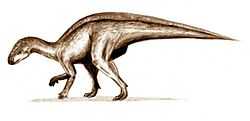Rhabdodontidae
| Rhabdodontidae Temporal range: Cretaceous, 100–66Ma | |
|---|---|
 | |
| Rhabdodon priscus | |
| Scientific classification | |
| Kingdom: | Animalia |
| Phylum: | Chordata |
| Clade: | Dinosauria |
| Order: | †Ornithischia |
| Clade: | †Ornithopoda |
| Clade: | †Iguanodontia |
| Family: | †Rhabdodontidae Weishampel, 2003 |
| Genera | |
Rhabdodontids were herbivorous ornithopod dinosaurs from the Cretaceous Period. Rhabdodontids were similar to large, robust hypsilophodonts, with deep skulls and jaws. The family was first proposed by David B. Weishampel et al. in 2002. The rhabdodontids were defined as "the most recent common ancestor of Zalmoxes robustus and Rhabdodon priscus and all the descendants of this common ancestor". In 2005, Paul Sereno defined the family as "the most inclusive clade containing Rhabdodon priscus but not Parasaurolophus walkeri".[1] The Rhabdodontidae includes the type genus Rhabdodon, Zalmoxes, and possibly Mochlodon and Muttaburrasaurus.[2] Rhabdodontid fossils have been found in Europe and Australia in formations dating from the Early to Late Cretaceous, 100 to 66 million years ago. Ősi et al. (2012) proposed that Rhabdodon underwent gigantism on the mainland, as opposed to Zalmoxes and Mochlodon experiencing nanism on island habitats.[3]

References
- ↑ Sereno, P.C. (2005). "Stem Archosauria Version 1.0." TaxonSearch. Available: http://www.taxonsearch.org/Archive/stem-archosauria-1.0.php via the Internet. Accessed 24 November 2010.
- ↑ McDonald, A.T., Kirkland, J.I., DeBlieux, D.D., Madsen, S.K., Cavin, J., Milner, A.R.C. and Panzarin, L. (2010). "New Basal Iguanodonts from the Cedar Mountain Formation of Utah and the Evolution of Thumb-Spiked Dinosaurs." PLoS ONE 5, 11: e14075. doi:10.1371/journal.pone.0014075 PMID 21124919
- ↑ Ősi, A.; Prondvai, E.; Butler, R.; Weishampel, D. B. (2012). "Phylogeny, Histology and Inferred Body Size Evolution in a New Rhabdodontid Dinosaur from the Late Cretaceous of Hungary". In Evans, Alistair Robert. PLoS ONE 7 (9): e44318. doi:10.1371/journal.pone.0044318. PMC 3448614. PMID 23028518.